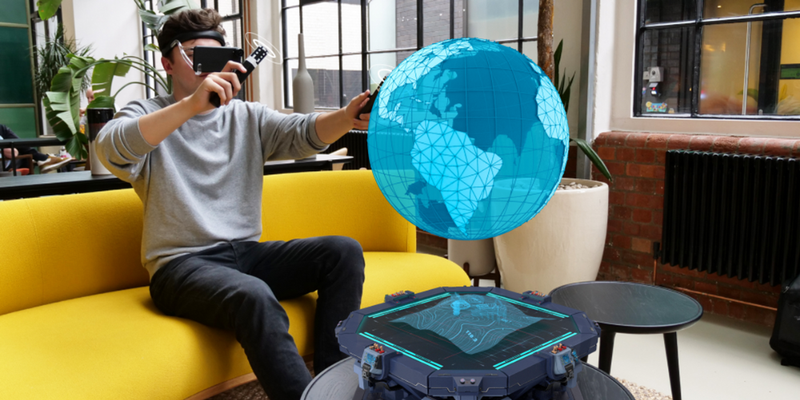Definition: Mixed reality, or MR, blends together elements of virtual reality (VR) and augmented reality (AR) to create a seamless experience between the physical and digital worlds. Enabling users to interact with virtual objects and environments while maintaining a connection to and awareness of the real world.
As immersive technology advances, how we are able to interact with digital immersive spaces and objects is changing. A major development in this is mixed reality (MR), a cutting-edge technology that merges the physical and digital worlds to create a unique and immersive user experience. In this blog, we will be delving into the immersive world of mixed reality, exploring its features and potential applications that hold the power to revolutionize various industries.
But before we get started on all of these applications first the answer to a very important question…
What is the difference between mixed reality and virtual reality?
The key differences between mixed reality (MR) and virtual reality (VR) are related to their level of immersion and interaction with the real world.
Immersion and Environment: VR aims to create a fully immersive digital environment that replaces the real world. Whilst MR combines elements of the real world with virtual content, allowing users to interact with both simultaneously.
Interaction: With VR users typically interact with the virtual environment using specialized controllers or gestures tracked by sensors. With MR whilst controllers and gestures are used to engage virtually users can also interact with physical objects.
Real-World Integration: VR isolates users from the physical world, creating a fully digital experience. Whilst MR blends virtual content with the real world, allowing virtual objects to interact with and respond to the physical environment.
While VR focuses on transporting users to fully virtual environments, MR blends the virtual and real worlds, allowing for interactive and immersive experiences that augment the physical world around you. Each technology has unique strengths and applications, catering to different user needs and use cases.
9 different ways to use Mixed Reality…
1. Gaming and Entertainment: Mixed reality presents an interesting prospect for gaming, offering players much greater levels of immersion and interactivity, allowing game worlds to blend seamlessly into real life. More specifically, tabletop gaming takes on a new life in mixed reality, with content being able to be tracked on a surface, tabletop or counter much more easily.
2. Education and Training: MR has huge potential when it comes to education and training both in the classroom as well as the corporate work environment. It can create lifelike simulations and scenarios, allowing students or employees to interact with virtual objects and environments, enhancing their understanding and practical skills in a more engaging, immersive and memorable way.
3. Healthcare: MR can be used to aid in medical training, allowing students to practice surgical techniques in a realistic yet controlled environment, as well as aid in explaining certain medicines to both patients and doctors. MR can create immersive training scenarios that just aren’t possible on a computer or handheld device, for example being able to study human organs up close, like the heart, brain or lungs and interact with them.
4. Remote Collaboration: Mixed reality is here to transform remote collaboration by enabling colleagues in different locations to interact and collaborate in a shared virtual environment, revolutionizing the way teams work together across distances. For example, teams in the automotive industry can be trained on new car or engine parts that need to be explained in greater detail, or engineers in the telecom space can be trained on new hardware, remotely across geographies.
5. Retail and E-commerce: Immersive and personalized shopping experiences are transforming the retail and e-commerce landscape enhancing customer engagement, increasing conversion and reducing return rates by enabling consumers to virtually try on clothes, visualize furniture in their homes, or see how different products fit into their environment.
6. Manufacturing and Industrial Design: Not only does MR have a crucial role to play in training here too, with real-time instructions and visual aids delivered via a headset, it also allows for better prototyping, assembly planning, and quality control when it comes to the manufacturing itself. Headsets like Zapbox which are much more affordable and lightweight, can be used to rapidly prototype for industrial use cases, without the need for bulky hardware.
7. Sports and Fitness: Athletes at the top of their game can use MR to analyze their performance, receive real-time coaching feedback, and visualize strategies, whilst your average gym enthusiast can have an immersive workout experience, following virtual trainers and competing with others in virtual environments.
8. Museums and Cultural Heritage: MR has the power to take the museum experience to the next level, whether it's allowing visitors to experience history with immersive walkthroughs or enabling them to explore the inaccessible, pulling virtual objects into real-world exhibitions that otherwise couldn't be included.
9. Architecture and Design: Mixed reality allows architects and designers to avoid costly mistakes by providing a way to experiment with concepts without the time and money associated with physical experimentation enabling them to see how a building or an interior design concept would look and function in the real world. It also provides an effective way to communicate these ideas to clients and stakeholders.
Whilst the use case and industries are diverse the value mixed reality offers is clear, the ability to blend the virtual and physical worlds, provides immersive experiences, enhances understanding, enables collaboration, and personalizes interactions.
Affordable mixed reality with Zapbox
Now, if you’re on a budget and want to explore the possibilities of mixed reality without the hefty price tag, our very own Zapbox provides a lightweight way to create and experience mixed reality with Unity. Zapbox comes with two active 6Dof controllers with buttons mirroring that of other popular headsets to maximize content compatibility.
 Grace Vassallo
Grace VassalloSenior Brand & Marketing Manager, Zappar
